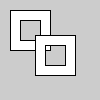Py5Graphics.begin_closed_shape()#
This method is used to start a custom closed shape.
Examples#

def setup():
py5.size(100, 100, py5.P2D)
g = py5.create_graphics(60, 60, py5.P2D)
with g.begin_draw():
with g.begin_closed_shape():
g.vertex(10, 10)
g.vertex(50, 10)
g.vertex(50, 50)
g.vertex(10, 50)
with g.begin_contour():
g.vertex(20, 20)
g.vertex(20, 40)
g.vertex(40, 40)
g.vertex(40, 20)
py5.image(g, 0, 0)
py5.image(g, 25, 25)
Description#
This method is used to start a custom closed shape. This method should only be used as a context manager, as shown in the example. When used as a context manager, this will ensure that Py5Graphics.end_shape() always gets called, just like when using Py5Graphics.begin_shape() as a context manager. The difference is that when exiting, the parameter CLOSE will be passed to Py5Graphics.end_shape(), connecting the last vertex to the first. This will close the shape. If this method were to be used not as a context manager, it won’t be able to close the shape by making the call to Py5Graphics.end_shape().
This method is the same as begin_closed_shape() but linked to a Py5Graphics object.
Underlying Processing method: PGraphics.beginShape
Signatures#
begin_closed_shape() -> None
begin_closed_shape(
kind: int, # Either POINTS, LINES, TRIANGLES, TRIANGLE_FAN, TRIANGLE_STRIP, QUADS, or QUAD_STRIP
/,
) -> None
Updated on March 06, 2023 02:49:26am UTC
